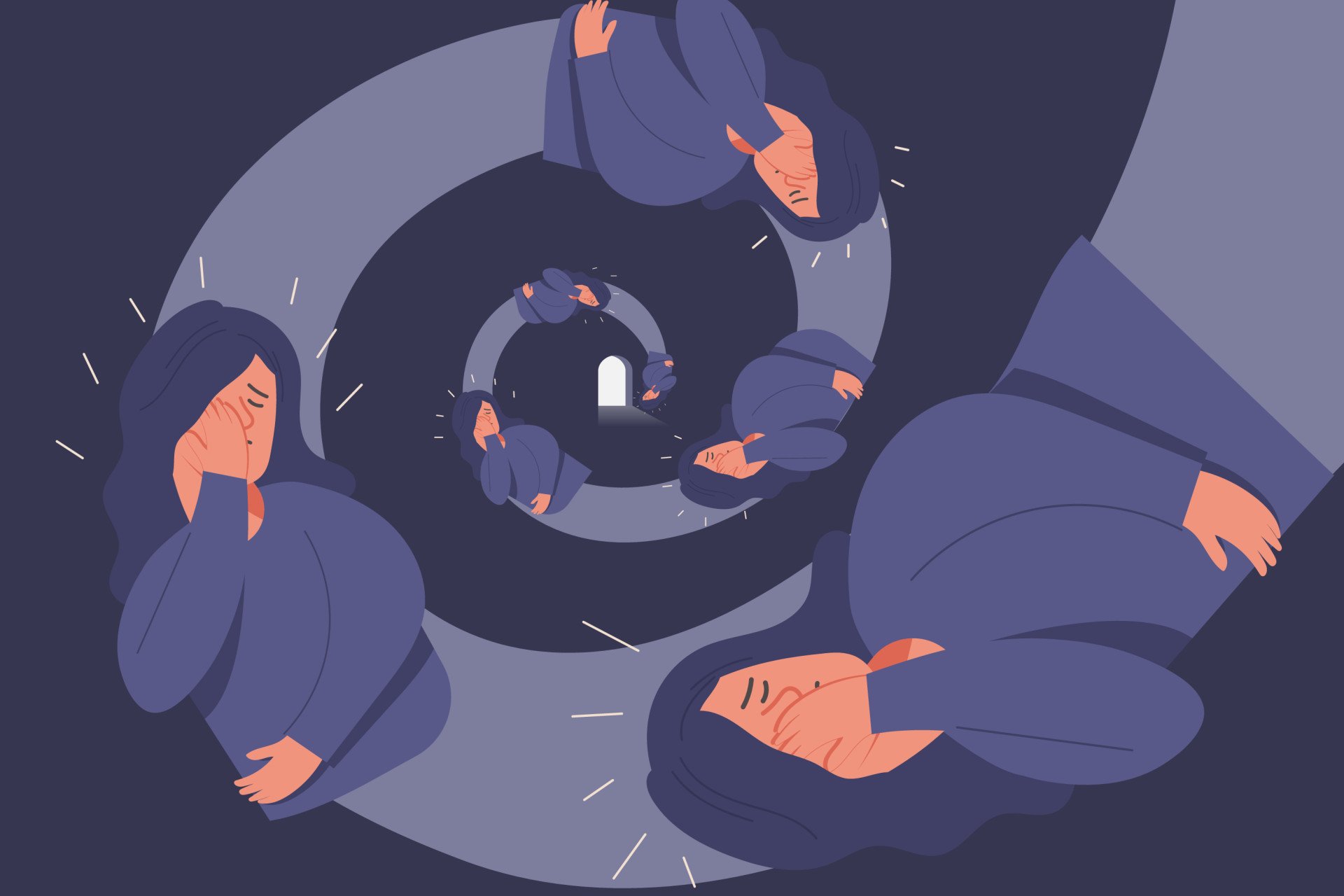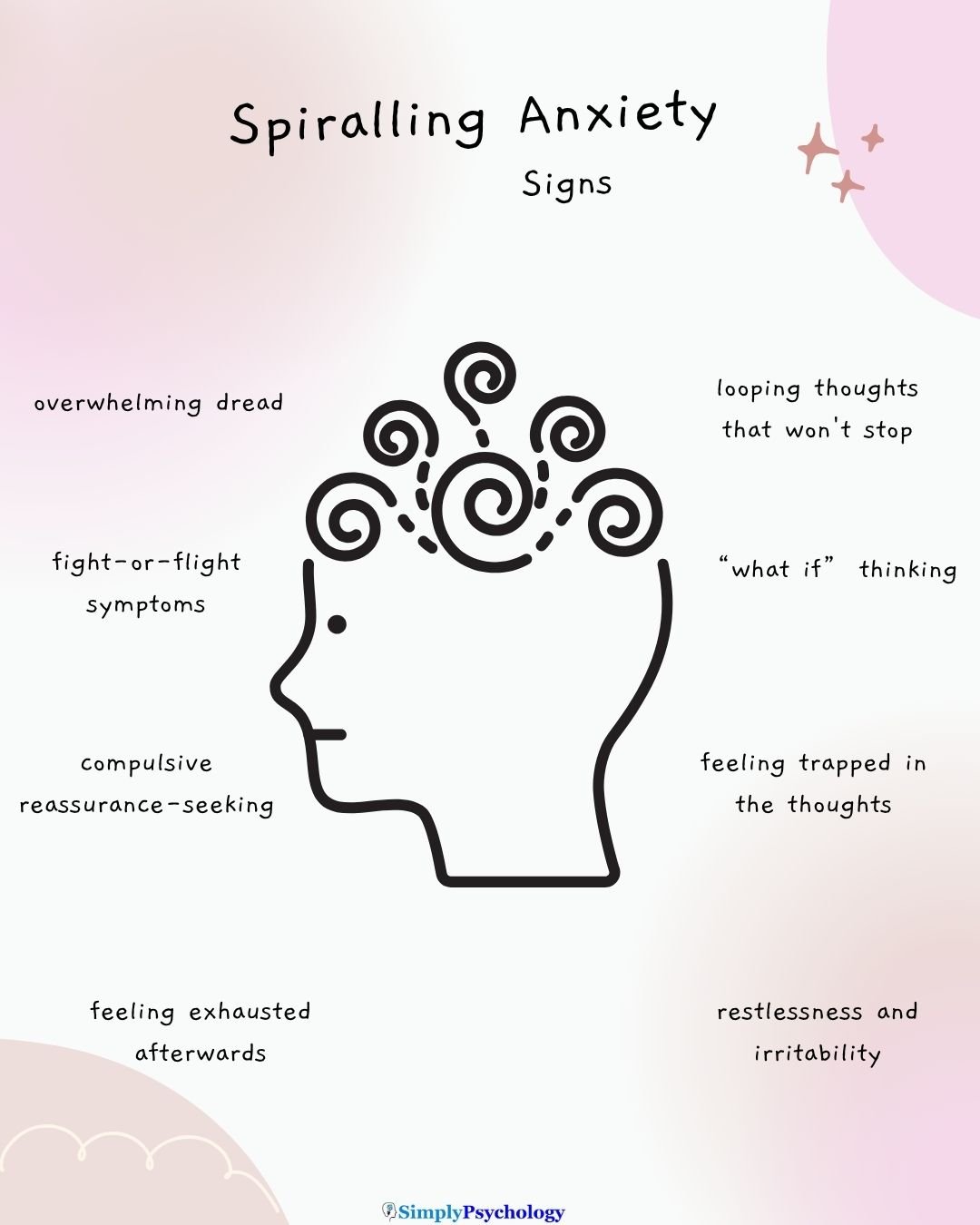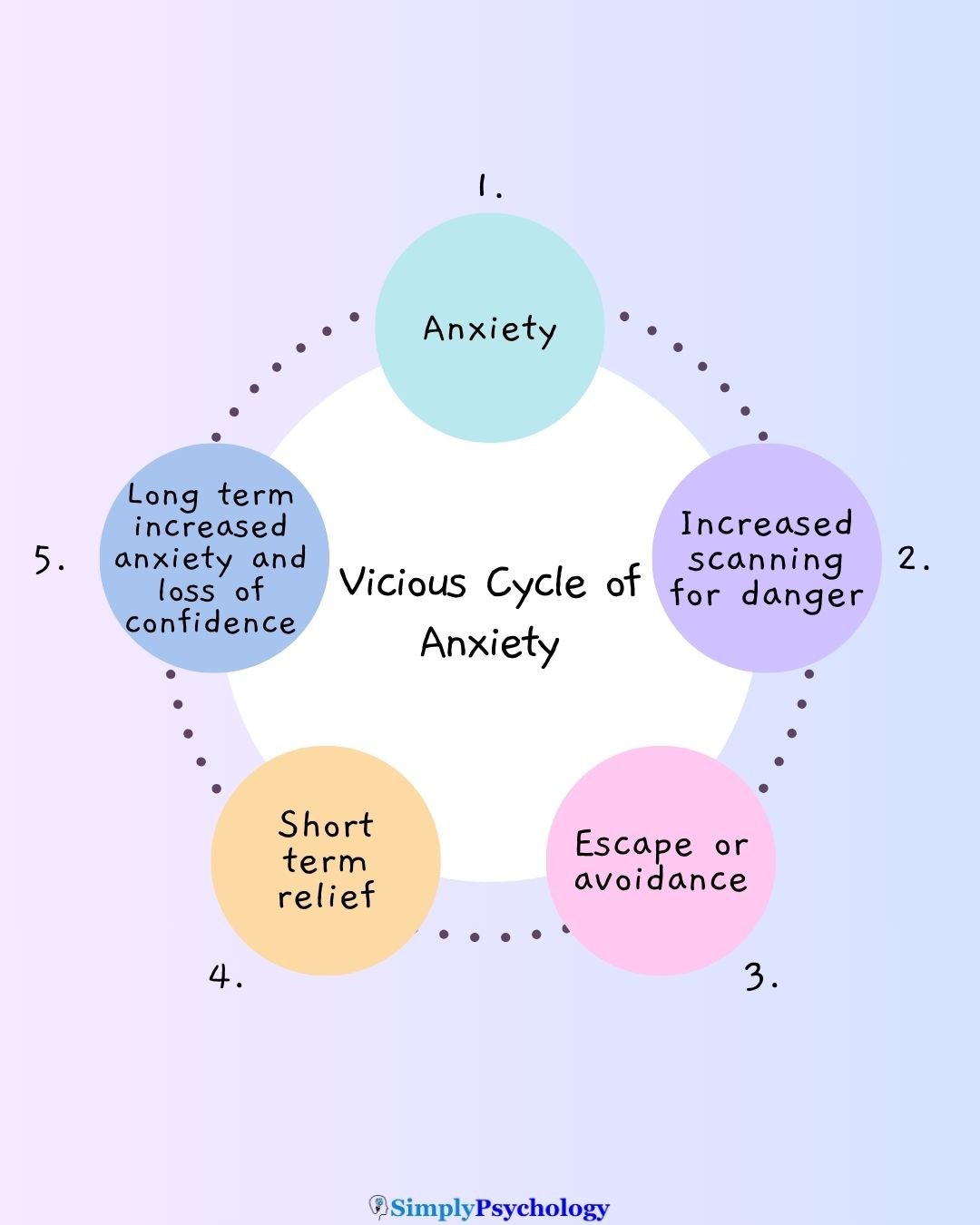An anxiety spiral happens when anxiety feeds on itself — a single worry sparks fear, physical stress reactions kick in, and those sensations trigger even more anxious thoughts.
Imagine lying in bed replaying a mistake at work. Soon, your mind jumps to “I’ll get fired, lose my home, everything will collapse.”
Your heart races, your chest tightens, and you feel trapped in your own thoughts. This isn’t ordinary worry — it’s a loop that feels impossible to escape.

Unlike everyday anxiety, which is tied to specific concerns, spirals pull you into an endless cycle of “what ifs.”
They differ from panic attacks (which hit suddenly and peak quickly) and from OCD rumination (which revolves around intrusive obsessions). Anxiety spirals often begin with a realistic concern that escalates far beyond proportion.
“I start with one small worry, then it explodes into imagining every worst-case scenario.”
Recognizing When You’re Spiraling
The first step is noticing when anxiety has shifted from typical worry into a spiral.
- Cognitively, your thoughts may race or loop uncontrollably. You might obsess over catastrophic outcomes — “If I don’t hear back soon, something terrible must have happened” — and feel powerless to redirect your mind.
- Emotionally, spirals bring dread, irritability, or a sense of impending doom. Many people describe feeling overwhelmed, helpless, or out of control.
- Physically, the body’s fight-or-flight response activates: pounding heart, chest tightness, dizziness, sweating, trembling, or stomach knots. These sensations can be frightening, convincing you something is “really wrong,” which further fuels the anxiety.
- Behaviorally, you might withdraw, avoid triggers, or seek reassurance — repeatedly checking, Googling symptoms, or calling loved ones for comfort. While these actions offer momentary relief, they reinforce the fear over time.
Below is a quick checklist of signs of an anxiety spiral:
- Intrusive thoughts: Non-stop “what if” thoughts or imagining worst-case scenarios you can’t dismiss.
- Intense emotions: Feeling panicky, trapped in worry, or unusually irritable and jumpy.
- Body in overdrive: Rapid heartbeat, sweating, upset stomach, dizziness, or shortness of breath without a medical cause.
- Avoidance/Reassurance: Urges to escape situations, call loved ones repeatedly to ask if things will be okay, or Google symptoms compulsively.
If you recognize several of these happening together, you’re likely in an anxiety spiral. Recognizing the pattern is the first step to stopping it.

Why Anxiety Spirals Happen
Anxiety spirals form through a feedback loop between thoughts, emotions, and body sensations.
A trigger — stress, uncertainty, or even fatigue — sparks anxious thoughts, which activate the body’s stress response.
Those physical sensations (racing heart, tense muscles) then confirm the fear, leading to even more anxious thoughts.
Common triggers include major life stressors (like exams, work conflict, or relationship uncertainty), past trauma, or even positive changes such as starting a new job or becoming a parent.
Lifestyle factors like poor sleep, excess caffeine, or alcohol use can also prime your system for anxiety.
Research from Scientific American shows that even one night of poor sleep can sharply increase next-day anxiety by impairing the brain’s emotional regulation.
Similarly, the American Medical Association notes that caffeine raises heart rate and breathing rate, often mimicking anxiety symptoms. Alcohol may seem calming at first, but as it wears off, stress hormones rebound — a phenomenon nicknamed “hangxiety.”
Modern life adds another layer: constant exposure to distressing news or social comparisons online. Psychologist David DeSteno explains that a nonstop flow of negative content convinces our brains we’re under continuous threat, heightening the risk of spiraling.
The Brain–Body Feedback Loop
Biologically, anxiety spirals are driven by communication between two key brain regions:
- The amygdala, which detects threats and triggers the fight-or-flight response.
- The prefrontal cortex, which helps assess and regulate those signals.
When you’re stressed, sleep-deprived, or overwhelmed, the prefrontal cortex struggles to rein in the amygdala’s alarm.
As a result, harmless sensations — like a racing heart — can be misinterpreted as danger. You think, “Something’s wrong with me,” which triggers more adrenaline and anxiety symptoms.
This cycle of thought → fear → physical response → more fearful thoughts can last for hours unless interrupted.
Cognitive distortions like catastrophizing (“I’ll never recover from this”) or black-and-white thinking (“Either I’m calm or I’m falling apart”) keep the loop alive.
Avoidance and “safety behaviors” — like always sitting near an exit or carrying medication “just in case” — provide temporary comfort but teach your brain that anxiety is unbearable.
Over time, that avoidance reinforces the fear, making future spirals more likely.

Breaking the Cycle in the Moment
When you catch yourself spiraling, the goal is to break the loop by calming your body, grounding your mind, or both. Here are some effective tools to help you regain control:
1. Ground with Your Senses (5-4-3-2-1 Technique)
Name five things you can see, four you can hear, three you can touch, two you can smell, and one you can taste.
This classic mindfulness technique roots you in the present moment and interrupts anxious thought loops.
Clinical psychologist Ellen Hendriksen explains that bringing attention to the senses “grounds us in the present and counting the items interrupts the spinning of our thoughts.”
2. Breathe Slowly and Deeply
Anxiety often makes us overbreathe, keeping us panicky. Instead, try slow, controlled breathing like the 4-7-8 technique (inhale for 4 counts, hold for 7, exhale for 8) or simply take slow belly breaths.
Exhaling for longer than you inhale triggers the parasympathetic nervous system – your body’s natural calming mechanism – which slows your heart rate and lowers blood pressure.
Remind yourself as you breathe, “These sensations are a false alarm — I’m safe right now.”
3. Use Temperature to Reset
Splashing your face with cold water or holding an ice pack against your skin can activate the body’s “dive reflex,” lowering heart rate and calming your nervous system.
It’s a jarring sensation that yanks your body out of panic mode momentarily, giving you a chance to regain control.
4. Label Your Thoughts (“Cognitive Defusion”)
Instead of believing every anxious thought, name it: “I notice I’m thinking that I’m going to fail this test and lose my job. That’s my anxiety talking.”
By doing this, you treat the frightening thought as a mental event – not an absolute reality.
This is a technique from acceptance and commitment therapy (ACT) called cognitive defusion. It creates a little distance between you and the anxious thought, making it less believable.
5. Move Your Body
Physical activity burns off excess adrenaline and signals to your body that the threat has passed. Even 60 seconds of brisk movement, shaking out tension, or stretching can help.
Stand up, roll your shoulders back, or do a “power pose” (hands on hips, feet firmly planted) for a minute.
Adopting a more relaxed or confident posture can send signals back to your brain that you are not in danger, helping to calm your nerves.
6. The 90-Second Reset
Neuroscientist Jill Bolte Taylor notes that the physiological lifespan of an emotion is about 90 seconds — after that, only your thoughts keep it alive.
The moment you notice the telltale signs of a spiral, do a grounding exercise or deep breathing for a minute and a half. By occupying that critical window with calming input, you prevent the feedback loop from snowballing.
Building Long-Term Resilience
Breaking a spiral in the moment is vital, but preventing future ones is just as important. These long-term habits strengthen your emotional stability and reduce chronic anxiety.
1. Practice Mindfulness and Acceptance
Regular mindfulness or journaling helps you observe anxious thoughts without being consumed by them. Noticing your thoughts without judgment can build resilience over time.
Acceptance — saying, “I feel anxious, and I can handle this” — prevents the secondary panic that often fuels spirals.
2. Challenge Distorted Thinking
Identify your most common thought traps, such as catastrophizing or assuming the worst. When calm, write them down and respond with rational counterstatements.
For example: “Even if I make a mistake, it doesn’t mean everything will fall apart.” Rehearsing these balanced thoughts trains your brain to react more calmly under stress.
3. Prioritize Rest and Physical Health
Quality sleep is one of the strongest defenses against anxiety. It restores the prefrontal cortex’s ability to regulate emotions, while sleep loss amplifies anxiety sensitivity.
Reduce caffeine and alcohol, stay hydrated, and eat regularly to stabilize energy and mood. Exercise — even a brisk 10-minute walk — releases tension and boosts neurotransmitters that counter anxiety.
4. Reduce Avoidance and Reassurance-Seeking
While it’s tempting to avoid triggers or constantly seek comfort, these behaviors reinforce fear.
Instead, challenge yourself gently to face anxiety-provoking situations in small, manageable doses. Each time you do, your confidence grows — and the anxiety loses power.
5. Use Gradual Exposure
Exposure therapy, a proven cognitive-behavioral approach, involves systematically facing fears.
Start small — if social situations make you spiral, meet one friend for coffee before tackling larger gatherings.
Each success teaches your brain that discomfort is temporary and survivable, rewiring your fear response.
6. Curate Your Mental Diet
Just as your body reacts to what you eat, your mind reacts to what you consume. Try to balance stressful media with positive, calming content — uplifting shows, music, or gratitude practices.
You can’t avoid all stress, but you can prevent your brain from marinating in constant threat cues.
Getting Help and Support
If anxiety spirals are frequent or disruptive, reaching out for professional help can make a huge difference. Persistent anxiety may signal a treatable condition such as generalized anxiety disorder or panic disorder.
Therapy
Cognitive Behavioral Therapy (CBT) helps you challenge anxious thoughts and reduce avoidance.
Acceptance and Commitment Therapy (ACT) teaches you to coexist with anxious feelings without letting them control you.
For those prone to obsessive rumination, Rumination-Focused CBT (RFCBT) directly targets repetitive thinking patterns and has shown promising results in reducing both anxiety and depression.
Medication
Doctors may prescribe SSRIs to lower baseline anxiety or short-term anti-anxiety medication for acute spirals.
Always consult a healthcare provider before starting or stopping medication.
Social support
Talking with a trusted friend or joining a support group can help you feel less alone and more grounded.
Even small gestures — a reassuring text, a hug, synchronized breathing with a partner — can calm your nervous system through co-regulation.
Studies show that perceived social support reduces anxiety symptoms and improves resilience.
If your anxiety spirals ever lead to dark or hopeless thoughts, seek help immediately through a crisis line or mental health professional. You are not alone, and effective help exists.

